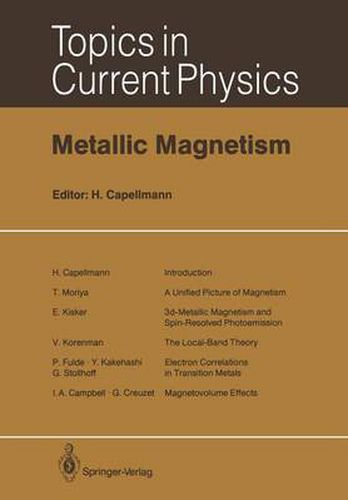Readings Newsletter
Become a Readings Member to make your shopping experience even easier.
Sign in or sign up for free!
You’re not far away from qualifying for FREE standard shipping within Australia
You’ve qualified for FREE standard shipping within Australia
The cart is loading…






This title is printed to order. This book may have been self-published. If so, we cannot guarantee the quality of the content. In the main most books will have gone through the editing process however some may not. We therefore suggest that you be aware of this before ordering this book. If in doubt check either the author or publisher’s details as we are unable to accept any returns unless they are faulty. Please contact us if you have any questions.
The magnetism of iron and other transition metals had been a subject of inten sive research for a long time, but the understanding of the microscopic origin of metallic magnetism was quite limited until the early 1970’s. During the last 10 to 15 years both theory and experiment contributed towards signif icant progress in this field, such that today a qualitative understanding has been achieved. The word qualitative indicates that the knowledge is still not complete; although many properties, the ground state as well as the finite temperature behaviour and the phase transition from magnetic order at low temperatures to the paramagnetic state at high temperatures, can be explained in a coherent way, a quantitative description still is not fully achieved. It is certainly appropriate to summarize the developments of the last 15 years and the present-day understanding of the field, this is the aim of this Topics volume. The form chosen is a collection of reviews, written by prominent scientists who themselves contributed decisively to the progress. Scientists with a general interest in the field as well as specialists and active researchers in metallic magnetism should be able to profit from the two-volume treatment. The subjects not covered extensively in the present first volume (in particular neutron scattering and electronic structure properties) will make up the second volume.
$9.00 standard shipping within Australia
FREE standard shipping within Australia for orders over $100.00
Express & International shipping calculated at checkout
This title is printed to order. This book may have been self-published. If so, we cannot guarantee the quality of the content. In the main most books will have gone through the editing process however some may not. We therefore suggest that you be aware of this before ordering this book. If in doubt check either the author or publisher’s details as we are unable to accept any returns unless they are faulty. Please contact us if you have any questions.
The magnetism of iron and other transition metals had been a subject of inten sive research for a long time, but the understanding of the microscopic origin of metallic magnetism was quite limited until the early 1970’s. During the last 10 to 15 years both theory and experiment contributed towards signif icant progress in this field, such that today a qualitative understanding has been achieved. The word qualitative indicates that the knowledge is still not complete; although many properties, the ground state as well as the finite temperature behaviour and the phase transition from magnetic order at low temperatures to the paramagnetic state at high temperatures, can be explained in a coherent way, a quantitative description still is not fully achieved. It is certainly appropriate to summarize the developments of the last 15 years and the present-day understanding of the field, this is the aim of this Topics volume. The form chosen is a collection of reviews, written by prominent scientists who themselves contributed decisively to the progress. Scientists with a general interest in the field as well as specialists and active researchers in metallic magnetism should be able to profit from the two-volume treatment. The subjects not covered extensively in the present first volume (in particular neutron scattering and electronic structure properties) will make up the second volume.